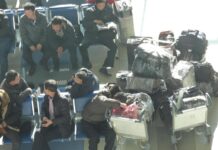[imText1]It will be interesting to see how North Korea will recover from flood damage since they are in desperate shortage of machinery and petroleum.
Even before the provinces around the Yellow Sea and Gangwon province could desiccate from the sudden attack of typhoon and torrential rain during the 10th~16th, another warning of torrential rain was signaled. This time the town of Wonsan City, Gangwon province was submerged in rain and severe damage was made to crops around the Yellow sea due to overflooding.
Previously, North Korean media was silent about the situation of flood damage, however are now televising images of people recovering from flood damages.
On the 25th Pyongyang broadcast informed that “Measures are being taken so that overflooding will not occur in mountain areas where there are many rivers, so that even if heavy rain does fall, crops will not be damaged due to excessive rain.” The news also reported that preventative measures are being taken along the banks of the Yellow River, so that crops would not be damaged.
North Korea’s Korean Central Broadcasting reported that “The areas of South Pyongan province, South Hamkyung province and Hwanghae province are all participating in a relief effort to combat the damages of torrential rain.”
Desperate need of machinery, man power the only form of work
In one way, the relief effort that has begun in Yalu River is partly understandable, although it is an image where everyone looks like a spade and backpack.
As there is little equipment such as excavators in North Korea, people have no choice but to use spades and hoes to complete the work.
Local authorities and the Department of Land Environment incorporated a ‘Flood recovery committee’ and ‘Water system committee.’ Directors of Forest Management Center, River Management Centre, Road Arrangements Office, Urban Management Office, and Land Management Office have been called to supervise the flood relief work.
Companies in flooded districts have closed factory doors, mobilizing their employees to areas of flood damage. It is basic manual labor that does not even exclude the unemployed.
Factories and groups of people are assigned areas in which damaged riverbanks are rebuilt and disconnected roads reconstructed with rock. However, the standard and safety assurance of the work is extremely poor.
According to need, the military is also being invested in areas of flood damage. However in mountain farms and areas where housing is minimal relief work is not conducted all year, but is sometimes left unattended.
The majority of roads connecting provinces and cities are not asphalted. It is only the main highways that connect Pyongyang-Wonsan, Pyongyang-Gaesung, and Pyongyang-Hyangsan that is asphalted. As a result, when there is a lot of rain, there is also a lot of damage.
Since 1998, ‘The Month for the Protection of Land Environment’ has been published every spring and winter. Although efforts are made to prevent flooding such as organization of roads and building up of riverbanks, there is no sturdy groundwork in manual labor.
One of the major difficulties amongst the flood relief work is the lack of food. The offer of emergency food relief from the World Food Programme (WFP) to provide distributions to the people who have lost houses in the flood is being declined by North Korean authorities as they are afraid of ‘monitoring.’
At present, people have nothing to eat but potatoes. People work eating potatoes as meals, as the first corn of the season will not be harvested until after August 15th.

















